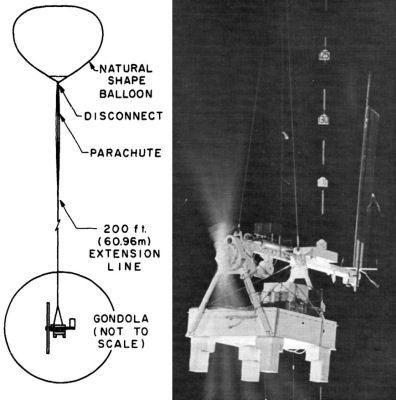Purpose of the flight and payload description
POBAL (POwered BALloon) was an experimental system developed in early 1970's by the Air Force Cambridge Research Laboratories (AFCRL) on which a propulsion unit was added to a free-flying balloon. After the discovery of seasonal occurrences of minimum wind fields in the lower stratosphere (zones where the wind speed was zero or near zero) the goal was create a system which could make possible of powering a natural shape balloon to remain in a fixed area. The design, development, fabrication and ground testing of the system was in charge of Goodyear Aerospace Corporation (GAC) while AFCRL had responsibility for the balloon, onboard instrumentation and flight test of the system.
At left we can see an scheme of the entire flight system and the propulsion gondola at full speed during a ground test (click to enlarge). The propulsion system payload consisted of the gondola structure, the power system, the rudder, rudder servo and heading autopilot, a propeller and an electric motor.
This particular flight was a test of a full-scale model of the POBAL gondola prior to flying the actual POBAL System. The mock-up gondola was fabricated by Air Force at Detachment 1, AFCRL. This mock-up was not powered, but all dimensions and its weight were correct. This balloon flight had the purpose of determining a launch procedure and the verification that the polyethylene balloon could carry the heavy payload.
The balloon for this flight was of similar size of the one to be used for POBAL mission, but was provided by Winzen research.
Details of the balloon flight
Balloon launched on: 9/11/1972
Launch site: Holloman Air Force Base, Alamogordo, New Mexico, US
Balloon launched by: Air Force Cambridge Research Laboratories (AFCRL)
Balloon manufacturer/size/composition: Zero Pressure Balloon Winzen 711.000 cuft Natural Shape Double Wall (1.5 Mils.) Stratofilm
End of flight (L for landing time, W for last contact, otherwise termination time): 9/11/1972
Balloon flight duration (F: time at float only, otherwise total flight time in d:days / h:hours or m:minutes - ): 2 h
Payload weight: 3150 lbs
The balloon was launched from Holloman AFB, New Mexico on September 11, 1972. To prevent the payload from swinging and rotating during launch, a rigid arm was extended from the crane to the front face of the gondola. A pin was attached to this arm and a cross brace was attached perpendicular to it. These pieces were attached to the gondola body to keep it in the proper orientation. Two other potential launch problems were also investigated during the test. Since the parachute risers slacken at payload release, they might hit the 9-ft tall POBAL rudder. Also, the danger of the very large propeller hitting the ground upon payload release had to be determined. The launch was smooth, with the gondola being released from the crane attachment without difficulty and there was no damage to the propeller or rudder during launch. The balloon reached float altitude and was successfully tested.
External references
- Balloon Flight Record Nº 44 National Center for Atmospheric Research, Summer 1972
- LDF Powered Balloon Program AFCRL's Instrumentation Papers No.198
2457If you consider this website interesting or useful, you can help me to keep it up and running with a small donation to cover the operational costs. Just the equivalent of the price of a cup of coffee helps a lot.


